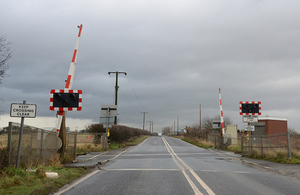Report 08/2018: Collision at Stainforth Road level crossing
RAIB has today released its report into a collision at Stainforth Road level crossing, 11 January 2018.

Image of Stainforth Road AHB level crossing (courtesy of the British Transport Police) taken from the direction of the motorist’s approach; the train was travelling from right to left.
Summary
At around 05:50 hrs on 11 January 2018, a car collided with the rear-most wagon of a stationary freight train at Stainforth Road Automatic Half-Barrier level crossing, near Doncaster. The crossing’s warning equipment was not operating and its half- barriers were raised when the car approached and entered the crossing. As a result of the accident, the driver of the car suffered scratches and bruises but their car was damaged beyond economic repair.
The train was at a stand because its brakes had been applied by the locomotive’s vigilance device. This occurred because the driver of the train did not respond to the device’s audible alarm in the time period permitted, probably due to the high level of ambient noise in the locomotive’s cab.
The car driver was not alerted to the presence of the train by the crossing’s warning devices because the design of the level crossing’s control circuits had permitted it to re-open to road traffic while it was still occupied by the train. The car driver did not see the wagon with enough time to take effective avoiding action, given her speed of approach. This was because the train was unlit and unreflective and also because there was no ambient light near the crossing.
The crossing’s control circuits dated back to its original installation in 1974. The control circuits had not been modified to incorporate later features which prove that trains are clear of a crossing before it re-opens. This was because a retrospective modification of this type was not mandated by relevant standards and guidance and also because the crossing’s circuits had not required modification during the life of the crossing for other reasons. The crossing had not been renewed or replaced prior to the accident, because Network Rail had assessed it as still having useful working life left. The level crossing risk assessment process used by Network Rail did not identify and address the risk of the original design of control circuit remaining in service without it having later design features intended to improve safety.
Recommendations
The RAIB has made two recommendations, both addressed to Network Rail. The first recommendation relates to an assessment of the risk at other level crossings where there is the possibility of it re-opening to road users with a train still present on the crossing and the development and implementation of mitigation measures, where appropriate, to address this risk. The second recommendation concerns the revision of the current standard relating to the design of new remotely monitored level crossings so that this requires them not to open to road users while a train is present.
Simon French, Chief Inspector of Rail Accidents said:
No motorist wants to encounter an obstruction on an unlit road after dark. Large animals or fallen trees are to some extent a normal part of rural life. But to find part of a freight train, stationary and with no visible lights, looming out of the darkness on a level crossing in the early hours of the morning, must have been a truly terrifying experience. There was no warning. The level crossing barriers had risen, and the road lights had stopped flashing, over a minute before the car approached the crossing. The driver of the car that hit this train was lucky to escape with her life.
This is not the first time in recent years that a motorist has encountered a train on a level crossing without any prior warning. At Moreton-on-Lugg in 2010, the signaller was able to raise the barriers with a train approaching because an old-fashioned design permitted it. The resulting collision cost the life of a passenger in a car. The situation was similar at Stainforth Road: the level crossing equipment was over forty years old and the way it was configured meant that the automatic barriers would rise even though the rear end of a train was still standing on the crossing.
RAIB’s report on the Moreton-on-Lugg accident recommended that Network Rail should enhance its level crossing management processes so that the risk posed by such historical designs could be better understood and more effectively managed. Six years later, this is another example of a latent condition in an old design which presented a risk to the safety of the public. I urge Network Rail to redouble its efforts to identify such conditions, to assess the risk they create and to consider ways of reducing risk to road users.
Notes to editors
- The sole purpose of RAIB investigations is to prevent future accidents and incidents and improve railway safety. RAIB does not establish blame, liability or carry out prosecutions.
- RAIB operates, as far as possible, in an open and transparent manner. While our investigations are completely independent of the railway industry, we do maintain close liaison with railway companies and if we discover matters that may affect the safety of the railway, we make sure that information about them is circulated to the right people as soon as possible, and certainly long before publication of our final report.
- For media enquiries, please call 01932 440015.
